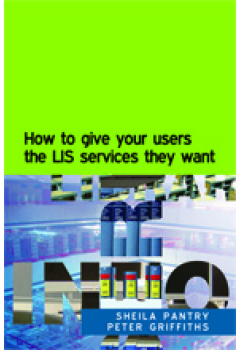
Primary tabs
You don't need to be an ALA Member to purchase from the ALA Store, but you'll be asked to create an online account/profile during the checkout to proceed. This Web Account is for both Members and non-Members.
If you are Tax-Exempt, please verify that your account is currently set up as exempt before placing your order, as our new fulfillment center will need current documentation. Learn how to verify here.
- Description
- Table of Contents
- About the authors
- Reviews
Stay a step ahead of your users’ ever-evolving needs despite rapidly changing technologies and shifts in information-seeking behavior. Librarians and information professionals who seek user-centric services will find fresh insight into the many benefits of analyzing user behavior, including more effective planning strategies, marketing approaches, cost-efficient budgets, and increased customer and management satisfaction
Co-authors Sheila Pantry and Peter Griffiths address the fundamental concepts and practices that facilitate successful, start-to-finish user behavior analysis. They outline the best methods for assessment, making effective use of information already available to your organization, categorizing users, and understanding your data. There are also clear answers to common questions about the uses of online data, the advantages of partnerships, remote users, and different types of user training.
This step-by-step guide will help you tackle user behavior analysis in your own organization and provide your users with exactly what they need.
1. Why this book?
- Defining your users
2. Understanding users – the what, why, where, when, how and who
- What services do LIS users need, and what should they have?
- Why we need to know about our users and their behaviour
- Where are the users of the service? How does this affect their ideas and expectations of good service?
- When to talk to users about their information needs
- How users obtain information and how to assess their habits
- Who do you need to consider when planning and performing the audit?
- What next?
- Summary
3. What is the current knowledge about your users and their needs – is it really predictable?
- Who and where are your users?
- Categorizing your users
- (Great) user expectations
- Can you predict what your users want?
- Summary
4. Great expectations: how LIS professionals can manage and train users
- Managing users of the service
- Levels of user expectations
- The role of the information professional in delivering customer services
- What do we really know about user needs and behaviour?
- Summary
5. Using information about past user behaviour
- The value of information about past user behaviour
- Library surveys
- What the results of your information audit may tell you about user needs
- Using the results of surveys to adjust services
- Using the results of surveys to decide whether to close services or create new ones
- The value of information over time
- Summary
6. Making the most of knowing your users
- Better strategic planning through analysis of user behaviour
- Communications
- Achieving cost benefits and making better use of budgets
- Summary
7. Keeping track of changes in what users want
- Helping users to review their information needs
- How to keep track of changes in what users want
- How and where to find information about changes in service
- Surveys and statistics
- Wider uses of information professional skills: reputation management
- Know your users: building user loyalty and keeping it
- What next?
- Summary
8. Tracking the future
- Keeping a watch on the wider changing world
- Your networks – what can they tell you?
- Users
- Summary
9. Future perfect?
- Some recommendations
- Is there a patron?
- Politics
- The library as place
- Shh, this is a digital library…
- Shaping a modern library
- Challenges for the future
Appendix 1. Reading list and references Appendix 2. Where to go for further information
"In a time of economic constraints this practical book gives ideas on how to ensure that your services are aligned with your user needs. It is not a magic bullet, but it gives information workers a wealth of practical how-to ideas which are supported by numerous examples and an extensive reading list."
— Library Management
"This book provides a myriad of practical and somewhat detailed ideas on how to assess what your LIS user wants, what you have and how to make up the difference. Pantry and Griffiths discuss current issues such as Web 2.0 applications more in an effort to make readers aware rather than offering practical suggestions on implementation. Yet the reader is not left feeling dissatisfied. This work contains a sizable annotated bibliography for each chapter as well as a section titled Where to Go for Information...Overall, this book is recommended to LIS managers and supervisors. It would make a practical and worthwhile contribution to any collection."
— Australian Library Journal


